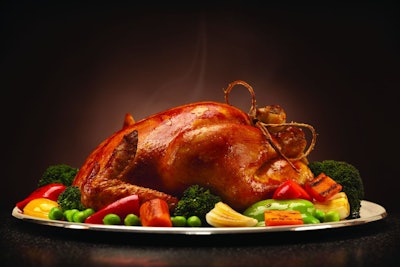
A shrinking population, concerns over the environment and animal welfare, and a greater desire for convenience will see European consumers eat less meat over the decade ahead. What Europeans will, however, begin eating more of, along with more vegetables, will be poultry, sheep and goat meat.
Poultry will be the winner in the diets of European Union (EU) citizens over the decade ahead. While this may be good news for producers, the forecasts released in the European Commission’s EU Agricultural Outlook 2022-2032, reveal that, while demand for poultry will increase, the rate of increase in both production and consumption will be far lower than Europe’s producers have become accustomed to.
Poultry, while not the only meat sector forecast to grow over the next 10 years, will win out against competitor proteins because of its healthier image, cheaper price, ease of preparation and lack of religious taboos.
Europe's positive poultry meat outlook
The Commission notes that, after 2022’s decrease in production, due to high input prices and outbreaks of highly pathogenic avian influenza (HPAI), the sector will return to growth over the decade ahead.
This growth, however, will be at only a fraction of that recorded over the last decade. While the EU’s poultry industry may have expanded by 2% per annum over the last 20 years, looking to the decade ahead, annual growth will slow to 0.2%.
A number of factors will contribute to this slower performance. The Commission cites environmental restrictions and changes in consumption patterns, but also that, with HPAI extending throughout the year rather than being a seasonal event, a greater challenge will be posed for EU production, particularly free-range production.
Where poultry meat consumption is concerned, the growth rate will similarly slow. Between 2012 and 2022, per capita poultry meat consumption in the EU grew by 1.9%. For the decade ahead, this figure will fall to 0.2%, meaning that, by decade end, per capita poultry meat consumption will have grown by 3%.
Growth, albeit at low levels, is also forecast for the EU’s poultry meat exports. Prior to COVID-19, growth in poultry meat exports was dynamic, the Commission notes, however, the pandemic, HPAI and high domestic prices brought that trend to a halt. Some recovery is now expected, with exports growing by 0.8% per year over the forecast period. By decade end, they should stand at 2.4 million metric tons (MT), with demand coming mainly from Sub-Saharan Africa, the Philippines and the U.K.
Where imports are concerned, there was a recovery in 2022, in part due to the duty-free agreement with Ukraine. This agreement is due to come to an end in mid-2023 and, without it, imports, mainly for foodservice and food processors, should fall back to pre-COVID levels, before reaching a level of 910,000 MT by 2032.
Meat consumption to fall by 12.3% over decade
What lies behind this lower growth rate for poultry meat or, where most other animal proteins are concerned, is contraction in demand.
The Commission notes that sustainability will become increasingly important over the decade ahead for producers and consumers. It continues that modernization, new technologies and changes in farming practices could lead to more efficient and environmentally friendly meat production, but, given the uncertainty of returns on investment, investment remains a challenge at producer level.
At consumer level, concerns about the environment and climate change will result in more attention being paid to how meat is produced and where it comes from. Consumers are also increasingly concerned by health and convenience. Importantly, the EU population is expected to be lower by 2032.
Per capita meat consumption, which averaged 67.5 kg between 2020-2022 will fall to 66 kg by 2032.
Pigmeat losing popularity
While the poultry industry can at least see some growth ahead, this is not expected to be the case in the swine industry.
In 2021, the industry produced 23.7 million MT, but this fell in 2022. Further declines of 1% per annum are forecast over the next 10 years, which would see output contract by 2.2 million MT.
Strong demand from China helped the industry to grow in 2021, but China is increasingly reducing its reliance on imports of pigmeat which will have a significant impact on European producers.
At home, environmental, societal and health concerns will see European consumers eat less pork and, by 2032, per capita pigmeat consumption is expected to fall by 4% to 31.1 kg.

Beef in trouble
The sector expected to witness the greatest decline over the forecast period is beef, which will continue its downward trend, falling by 0.6 million MT over the next decade, or by 9%.
Slaughter weights in the EU are forecast to continue upwards, due to greater use of technology and a larger share of beef-type animals in the bloc’s herd, while a shift to organic and extensive product systems may partially counteract beef’s downward trend.
Consumption contracted in 2022 due to low availability and high prices, and this trend is expected to continue. The Commission believes that per capita consumption may drop by 7.8% over the decade ahead.
Sheep and goat meat climb higher
Poultry will not be alone in recording growth over the decade ahead, the same growth rate is forecast for sheep and goat meat production. With a 0.2% annual expansion, sheep and goat meat output will reach 645,000 MT by 2032.
Supply is forecast to be tight, and prices favorable. Prices will, however, trend downwards but remain significantly higher than before COVID-19.
Per capita consumption is expected to remain relatively stable over the forecast period at around 1.3 kg.

















